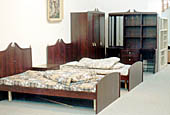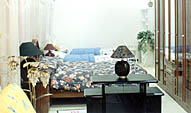
Yemen’s Home Furniture Industry: THE TIDE OF CHANGE! [Archives:1999/05/Business & Economy]
February 1 1999
History of Carpentry:
The Yemeni carpentry industry is over 3000 years old. There are ancient engravings and paintings which show craftsmen busy in woodwork.
During the heyday of the Islamic civilization, Yemeni carpentry skills spread throughout Arabia, the Levant, Persia, India and beyond; as well as to North Africa, the Middle East, Andalusia, and other territories.

Yemeni craftsmen developed lots of skill and talent. Household furniture like beds, stools, chairs, tables, cupboards, etc., were designed and produced. Also produced were doors, windows, balconies, and other protective extensions. Many kinds of tools and simple machines such as hammers, levers, axes, saws, etc., have been developed. Some of them are still in use today.
Traditional wood products are made from local trees.
During the days of British colonial rule of Aden, carpentry curricula were developed and taught in schools. One of the founders of modern carpentry sciences in Aden was the late Mr. Ahmed Sa’eed Al-Masri, a scholar of the British Royal Corps.
But, it was with the coming of the September Revolution of 1962 that the door was opened wide for Yemen to interact with the world.
The Tide of Change:
Following the Revolution, there was a much higher level of exchange and interaction between Yemen and the rest of the world. Unfortunately, this has had a negative impact on Yemen’s indigenous carpentry industry. For all practical purposes, the local industry has disappeared and was replaced by imported furniture and other wood products.
Most furniture today is either directly imported, or the raw materials are imported and local carpenters make the products.
Various efforts to prop up local carpentry through subsidies, tax breaks and vocational training have not been able to make a dent on the foreign on-slaught. To add insult to injury, most families and companies prefer imported finished furniture. These are both of better quality and lower prices. While raw wood is often imported from Malaysia, Indonesia, Sweden, etc. ready-made furniture products are often imported from Italy, Southeast Asia, and other places.
Quality & Prices

Carpenters usually buy imported wood from wholesalers and general distribution agents. Local wood production today represents less than 10% of the needs of the furniture market.
Placards (compressed applacash) with a thickness of 4 mm, 9 mm, 12 mm, 15 mm, and 18 mm are available. The unit prices for a 1.8 meter by 3.6 meter board are YR 600; YR 1,300; YR 1,800; YR 2,300; and YR 2,600 respectively. Though unit pricing is available for small buyers, the cost of wood is mostly quoted by bulk volume, and not by weight, length, or width. Malaysian (meranthi) wood, for example, is measured in cubic meters, and sold at a price of roughly YR 36,000 a cubic meter. Similarly, Swedish wood is priced at YR 50,000 for a single office table.
Furniture Market:
The cost of household furniture can vary steeply depending on the quality and number of pieces.
The first factor is the number of pieces and quality of the furniture. Most families usually demand the following:
– Sitting (living) room furniture would include a sofa and 4 armchairs;
– Bedroom furniture would comprise a family bed, a couple of single beds, a cabinet, and a desk with a mirror;
– Dining room furniture would involve a kitchen table and chairs, and numerous shelves and drawers. and possibly a sofa and accompanying chairs.
A low-income family would invest a total cost of somewhere between YR 250,000 to YR 400,000.
A middle-income family would spend up to a million.
A well-to-do family could furnish its home more elaborately and with ready-made foreign furniture. The cost would then rise to a few million Rials. The cost could further rise if the buyer wants chiselled engravings on first-quality wood.
Room furniture designs are tailor-made based on catalogs and pictures. Sculptors have enjoyed high demand for their skills because of the ever more refined taste of high-income families.
Second-hand furniture stores have become a common feature as many families who want to save on purchases first start there, but the quality is often below acceptable standards.
Payment Facilities:
In all cases, don’t forget to argue about prices. You can often get 5% to 30% discounts on the price for all home furniture. This is especially true if you are paying cash for your needs.
There are two ways of paying in installments. If the goods are purchased ready-made from a show-room, then a system of installments can be agreed upon. Usually, the shop-owner will allow up to 6 months to complete payment of the value of the products. Often, the goods are delivered on the day of the agreement, when an initial down-payment is made. This is usually 50% of the total value.
A person can also make a down-payment on goods that are being produced. A customer can agree with a carpenter to make a deposit. Over a few weeks, the carpenter will then produce the furniture, and payment is made as the work progresses.
Learning from the World:
The Republic of Yemen has started to learn from foreign experience. The learning process is at both ends of the market – supply and demand. On the one hand, our carpenters – whether those who have gone through vocational institutes, or those who have apprenticed on the basis of ‘on-the-job training’ – have now learned many new skills from foreigners. On the demand side, the taste of Yemenis has changed visibly over the last two decades.
Yemeni carpenters today apply practically Western designs to the furniture industry. The first such input came from China – through specialized Chinese curricula in technical schools. Then came foreign proficient workmanship through Egyptian. Syrian, Indian, and Filippino carpenters. Finally came the professional catalogs. Many Yemeni carpenters also learned the skills in 5-stars hotels, large international firms, oil companies, and other enterprises. Formal training has also left its mark. The three major technical carpentry schools – the Sanaa Technical School, the Bir Basha Technical School in Taiz, and the Aden Technical School have graduated students who produced a lot of successful works.
On the demand side, most Yemenis have now adapted to modern dining and living habits. Beds are a standard feature. Eating on tables is increasing. Writing and reading on desks and tables is normal. Packing clothes in cupboards is standard. These habits, which were first introduced only a few decades, are today part of the normal behavior of the Yemeni people.
Yemeni versus Imported Products:
Yemen carpenters now successfully compete with imported furniture products. Local carpenters have proven their ability to meet demand needs in both quality and prices.
Today’s local carpentershave tried to append fascinating beauty to the outward appearance, producing modern styles and firmness. One expert carpenter told me once, “We try hard to satisfy the wishes of our customers. We continue to upgrade the quality of our service!”
The success of local products lies in two factors:
a) Blending of local with international styles;
b) Using solid wood rather than compressed placards in producing the furniture. This gives the goods longer durability.
Modernizing the Sector:
Unfortunately, the burden of modernizing and up-grading this sector has fallen almost entirely on the private sector – and a small section of it, at that. Therefore, growth and development have been intermittent and slow.
Financing has not been available to the small and medium size carpentry workshops. This holds back the purchase of needed equipment and machinery.
Government financing and bank credits are not available. However, some entrepreneurs have recently been able to benefit from the Social Fund Program which provides small-scale financing. Loans are given to carpenters for the purchase of machinery, equipment, and materials such as wood.
As a sector that provides employment to a large sector of semi-skilled workers, and generates income directly and through value added and linkages, the state should support the carpentry industry.
Conclusion:
In my opinion, the carpentry industry needs a lot of development and subsidies from government, public, and private sectors. Our global system takes care about such cases raised from its necessity and importance to the family and society. A civilized nation is being indicated by wealthy life style of furniture, and luxuries. Therefore, we should keep in our eyes all issues related to the development of efficient management and mass production. Yet, our society still faces various problems, which need deep understandings, piercing sights, and courage stances. A good management with abiding resources ought to accelerate the wheel of development and ease problems created from demography or environment. The country has to make co-operative agreements with regional and international organizations to be provided with data, sustenance, and experience to solve its economic crises. In addition, Yemen needs to issue laws or republican decrees to organize the underwriting of shares to establish new projects to attract foreign investments. I am optimistic about the future of carpentry in Yemen, although necessary steps has to be taken to organize and license the labor force engaged in this occupation. People say. “Organizing carpentry knowledge is 99% of success, while 1% depend on government.” As we reached the coming century, every carpenter has to develop a standard quality style for carpentry workshop like products of high industrial countries. It is just a matter of consumer taste of average persons, before they are various volume shapes of wooden sculptures.
By: Ghassan Al-Ahdal,
Yemen Times
——
[archive-e:05-v:1999-y:1999-d:1999-02-01-p:./1999/iss05/b&e.htm]


